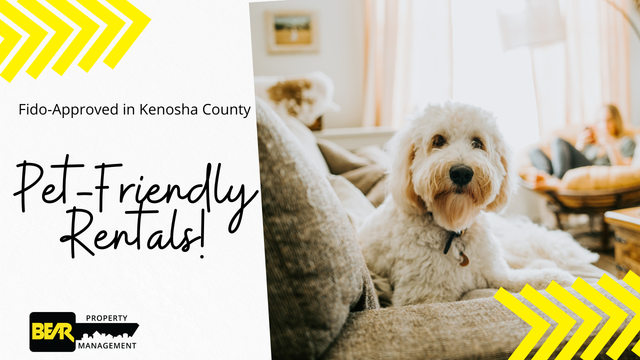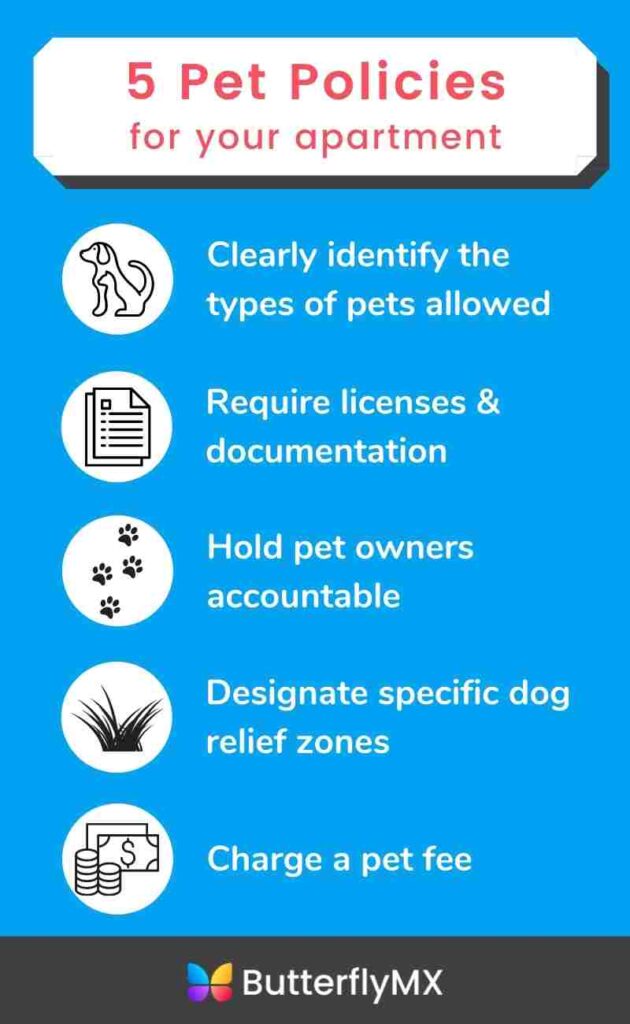Key Takeaways
Allowing pets can increase your rental income by 20-30% due to higher rent potential.
Pet-friendly properties attract a larger pool of potential tenants, reducing vacancy periods.
Tenants with pets often stay longer, minimizing turnover and related costs.
Potential downsides include property damage, noise, and cleanliness issues.
Implementing pet policies and screening processes can mitigate risks and ensure responsible pet ownership.
Should You Make Your Rental Property Pet Friendly?
Why This Decision Matters to Your Rental Business
Deciding whether to allow pets in your rental property is a significant choice that can impact your rental business in various ways. Many tenants are pet owners, and your stance on this issue could determine how quickly you fill vacancies and the quality of tenants you attract. Let’s explore the pros and cons to help you make an informed decision.
“Pet-Friendly Rentals in Kenosha County …” from www.bearpropertymanagement.com and used with no modifications.
The Pros of Allowing Pets in Rental Properties
Higher Rent Potential
Making your rental property pet-friendly can increase your rental income as many tenants are willing to pay extra for a place that accommodates their pets. This can be particularly true for properties that are near pet-friendly parks or other amenities.
Allowing pets in your rental property can significantly increase your rental income. Many pet owners are willing to pay a premium to secure a home for their furry friends. Typically, landlords can charge an additional $25 to $50 per month for pet rent, and sometimes even more for larger animals. This extra income can add up quickly and contribute to a more profitable rental business.
Expanded Tenant Pool
Making your rental property pet-friendly can significantly expand your tenant pool. Many renters have pets and are looking for properties that accommodate their furry friends. Allowing pets can make your property more attractive to a larger number of potential tenants, thereby reducing vacancy rates and increasing rental income. Additionally, pet owners often stay longer in pet-friendly rentals, providing more stability for landlords. However, it is essential to consider the potential drawbacks, such as damage caused by pets and additional cleaning costs. For instance, pet-friendly landscaping can help mitigate some of these issues.
When you allow pets, you open your property to a larger pool of potential tenants. According to a survey by the American Pet Products Association, 67% of U.S. households own a pet. By accommodating these pet owners, you significantly increase the number of interested renters, making it easier to fill vacancies quickly. For more information, check out this article on allowing pets in your rental property.
Longer Tenancies
Tenants with pets tend to stay longer in pet-friendly properties. The reason is simple: finding a rental that accepts pets can be challenging. Once pet owners find a suitable home, they are less likely to move, leading to longer tenancies and reduced turnover costs for landlords. This stability can save you money in the long run by minimizing the expenses associated with frequent tenant turnover, such as cleaning, repairs, and marketing. For more insights, check out the pros and cons of pet ownership.
Responsible Pet Owners as Responsible Tenants
Allowing pets in your rental property can attract responsible pet owners who often make responsible tenants. According to SmartMove, pet owners tend to stay longer and take better care of the property. This can lead to a more stable and reliable rental income for landlords.
Responsible pet owners often make responsible tenants. Caring for a pet requires a certain level of responsibility, which can translate into how they treat your property. Many pet owners understand the importance of maintaining a clean and damage-free home to ensure they can continue to find pet-friendly rentals in the future.
Besides that, pet owners are usually more considerate of their neighbors and the property, knowing that any issues could jeopardize their ability to keep their pet. This can lead to a more harmonious living environment for all tenants. For example, choosing pet-friendly plants can also contribute to a pleasant atmosphere.
The Cons of Allowing Pets in Rental Properties
Potential Property Damage
One of the primary concerns for landlords when considering allowing pets in their rental properties is the potential for property damage. Pets, especially young ones, can sometimes cause damage to carpets, walls, and furniture. However, some landlords find that pet owners are often more responsible tenants, taking extra care to maintain the property. For example, certain pet-safe plants can be used to minimize damage and create a more pet-friendly environment.
One of the most significant concerns for landlords is the potential for property damage caused by pets. Pets can scratch floors, chew on fixtures, and cause other types of damage that can be costly to repair. However, implementing a thorough screening process and requiring a pet deposit can help mitigate these risks.
It’s essential to outline clear guidelines in your lease agreement regarding pet-related damages and ensure tenants understand their responsibilities. Regular property inspections can also help you catch any issues early and address them before they become more significant problems. For more insights, check out the pros and cons of bottle brush trees for pet owners.
Noise Concerns
Another common issue with allowing pets in rental properties is noise. Dogs barking, cats meowing, and other pet-related noises can disturb neighbors and lead to complaints. This is especially problematic in multi-family properties where sound travels easily between units. To address this, you can include noise regulations in your pet policy and ensure tenants understand the importance of managing their pets’ behavior.
Additionally, conducting a thorough screening process can help you select tenants with well-behaved pets. Asking for references from previous landlords and meeting the pet in person can give you a better idea of how well the pet will fit into your property. For more tips, check out the pros and cons of bottle brush trees for pet owners.
Odors and Cleanliness
Pets can sometimes bring unwanted odors and cleanliness issues into a rental property. Accidents can happen, and if not cleaned promptly, they can lead to lingering smells that are difficult to remove. Furthermore, pet hair and dander can accumulate, making the property less appealing to future tenants.
To mitigate these concerns, you can require tenants to maintain a clean living environment and address any pet-related messes immediately. Regular property inspections can also help ensure that tenants are keeping up with cleanliness standards. Including a professional cleaning clause in the lease agreement can ensure the property is thoroughly cleaned when the tenant moves out.
Injuries and Liability Risk
Allowing pets in your rental property can also increase the risk of injuries and liability issues. Pets, especially dogs, can bite or scratch other tenants or visitors, leading to potential legal problems for you as the landlord. To protect yourself, it’s crucial to require tenants to carry renters insurance that includes liability coverage for their pets.
Besides that, you can implement breed and size restrictions to minimize the risk of aggressive behavior. Screening pets and their owners can also help you identify responsible pet owners who are less likely to have problematic pets.
“5 Apartment Pet Policies to Implement …” from butterflymx.com and used with no modifications.
Solutions for Managing Pets in Rental Properties
While there are potential downsides to allowing pets, there are also effective strategies for managing these challenges. By implementing clear policies and guidelines, you can create a pet-friendly environment that benefits both you and your tenants.
Pet Policies and Agreements
When considering whether to make your rental property pet-friendly, it is essential to establish clear pet policies and agreements to ensure both tenant and landlord are protected. These agreements should outline the types of pets allowed, any associated fees, and the tenant’s responsibilities regarding pet care and property maintenance.
Creating a comprehensive pet policy is essential for managing pets in your rental property. This policy should outline the types of pets allowed, any breed or size restrictions, and the number of pets permitted per unit. Additionally, it should include guidelines for pet behavior, noise, and cleanliness. For example, you might want to consider allowing pet-safe plants in your property to ensure a safe environment for all tenants.
Make sure to include the pet policy in the lease agreement and have tenants sign a separate pet agreement acknowledging their responsibilities. This can help protect you legally and ensure tenants understand the rules they need to follow.
Charging Pet Deposits or Fees
When deciding whether to allow pets in your rental property, one important consideration is whether to charge pet deposits or fees. This can help cover potential damages caused by pets and provide peace of mind for landlords. For more information on this topic, check out this article on allowing pets in rental properties.
To cover potential damages and additional cleaning costs, you can charge a pet deposit or pet fee. A pet deposit is typically refundable, while a pet fee is a one-time, non-refundable payment. The amount you charge can vary, but it’s common to require a deposit of $200 to $500 or a monthly pet fee of $25 to $50.
These charges can help offset the costs of any pet-related damage and ensure you have funds available for necessary repairs or cleaning. Be sure to comply with local laws and regulations regarding pet deposits and fees, as these can vary by location. For example, understanding which shrubs that withstand dog urine can be beneficial for maintaining your rental property’s landscape.
Screening Tenants with Pets
Screening tenants with pets is crucial for ensuring you select responsible pet owners who will take good care of your property. Here are some steps you can take during the screening process, such as verifying if the pets are safe for the property environment, like ensuring Angelonia is not toxic to dogs and cats.
Request references from previous landlords to learn about the tenant’s history with their pet.
Meet the pet in person to assess its behavior and temperament.
Ask for proof of vaccinations and any necessary licenses.
Require renters insurance that includes liability coverage for the pet.
By thoroughly screening tenants and their pets, you can reduce the risk of property damage and other issues. For instance, understanding the pros and cons of certain plants for pet owners can also help in maintaining a safe environment.
Maintenance and Cleanliness Guidelines
Maintaining a clean and well-kept property is essential when allowing pets. Include guidelines in your lease agreement that outline tenants’ responsibilities for cleaning up after their pets and maintaining a tidy living environment. Regular property inspections can help ensure tenants are following these guidelines and address any issues early on. For example, ensuring that tenants have pet-safe plants can also contribute to a safer and cleaner environment.
Additionally, consider providing tenants with information on local pet care services, such as dog walking and grooming, to help them keep their pets well-behaved and clean.
Case Studies of Pet-Friendly Rental Success
Many landlords have found success by making their rental properties pet-friendly. For example, some have even gone as far as to plant pet-friendly sweet alyssum in their gardens to create a welcoming environment for tenants with pets. These case studies highlight the benefits of accommodating pet owners, such as increased tenant satisfaction and longer lease agreements.
Real-life examples can provide valuable insights into the benefits and challenges of allowing pets in rental properties. Here are a few case studies that highlight the positive outcomes of pet-friendly rentals:
One landlord in San Francisco decided to allow pets in their multi-family property. They implemented a comprehensive pet policy, charged a pet deposit, and screened tenants thoroughly. As a result, they attracted responsible pet owners who took excellent care of the property. The landlord reported higher rental income, reduced vacancy periods, and longer tenancies.
Another landlord in Chicago allowed pets in their single-family rental home. They required tenants to carry renters insurance with liability coverage and conducted regular property inspections. The tenants, who had two dogs, stayed in the property for five years and maintained it in excellent condition. The landlord experienced minimal turnover costs and enjoyed a stable rental income.
These case studies demonstrate that with the right policies and management strategies, allowing pets can be a successful and profitable decision for landlords.
Real-Life Examples of Positive Outcomes
One landlord in San Francisco decided to allow pets in their multi-family property. They implemented a comprehensive pet policy, charged a pet deposit, and screened tenants thoroughly. As a result, they attracted responsible pet owners who took excellent care of the property. The landlord reported higher rental income, reduced vacancy periods, and longer tenancies. For more information on allowing pets in rental properties, you can visit this resource.
Another landlord in Chicago allowed pets in their single-family rental home. They required tenants to carry renters insurance with liability coverage and conducted regular property inspections. The tenants, who had two dogs, stayed in the property for five years and maintained it in excellent condition. The landlord experienced minimal turnover costs and enjoyed a stable rental income.
These case studies demonstrate that with the right policies and management strategies, allowing pets can be a successful and profitable decision for landlords. For more insights, you can read about allowing pets in rental properties.
Lessons Learned from Pet-Friendly Rentals
From these case studies, several key lessons emerge:
Implementing clear pet policies and agreements is crucial for setting expectations and protecting your property.
Charging pet deposits or fees can help cover potential damages and additional cleaning costs.
Thoroughly screening tenants and their pets can reduce the risk of property damage and other issues.
Regular property inspections can help ensure tenants are maintaining cleanliness and addressing any pet-related concerns promptly.
Requiring renters insurance with liability coverage can protect you from potential legal issues related to pet injuries.
By following these best practices, you can create a pet-friendly rental environment that benefits both you and your tenants.
Conclusion: Making an Informed Decision
Deciding whether to allow pets in your rental property is a significant choice that requires careful consideration of the pros and cons. Allowing pets can increase your rental income, attract a larger pool of potential tenants, and lead to longer tenancies. However, it also comes with potential downsides, such as property damage, noise concerns, and liability risks.
Weighing the Pros and Cons
When deciding whether to make your rental property pet-friendly, it is essential to weigh the benefits and drawbacks. Allowing pets can attract a broader range of tenants, as many renters own pets and seek accommodations that welcome them. However, it’s crucial to consider potential damages and additional cleaning costs that might arise. Additionally, ensuring that the property is safe and suitable for pets, such as having pet-safe plants in the garden, can be a significant factor in your decision.
To make an informed decision, weigh the benefits and risks carefully. Implementing clear pet policies, charging pet deposits or fees, screening tenants thoroughly, and conducting regular property inspections can help mitigate potential issues. By managing pets effectively, you can create a successful and profitable rental business. For example, understanding which plants are safe for pets, like Forsythia, can also be beneficial.
Frequently Asked Questions (FAQ)
What types of pets are most commonly allowed in rentals?
Most landlords allow common household pets such as cats and dogs. However, some may also permit small animals like birds, hamsters, or fish. It’s essential to specify the types of pets allowed in your pet policy and include any breed or size restrictions.
How can I minimize potential pet damage?
To minimize potential pet damage, implement a thorough screening process for tenants with pets, including references from previous landlords. Charge a pet deposit or pet fee to cover potential damages and conduct regular property inspections to address any issues early on. Additionally, outline clear guidelines in your lease agreement regarding pet-related damages and cleanliness responsibilities.
Are there insurance considerations when allowing pets?
When considering allowing pets in your rental property, it’s important to evaluate all potential risks and benefits. One aspect to consider is whether certain pet-friendly plants in the vicinity might affect your insurance policy. Ensuring that your property is safe and accommodating for pets can help in mitigating potential issues and maintaining a harmonious living environment for all tenants.
Yes, there are insurance considerations when allowing pets in your rental property. Require tenants to carry renters insurance that includes liability coverage for their pets. This can protect you from potential legal issues related to pet injuries or damages. Additionally, check with your own insurance provider to ensure your policy covers pet-related incidents.







